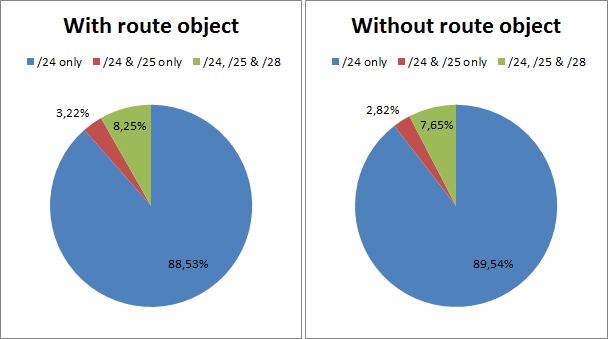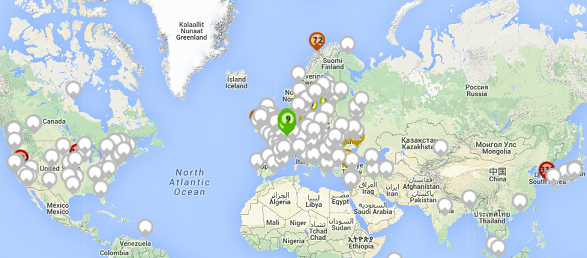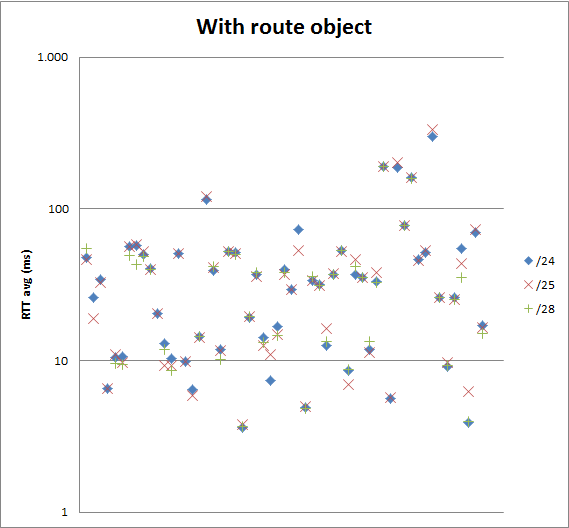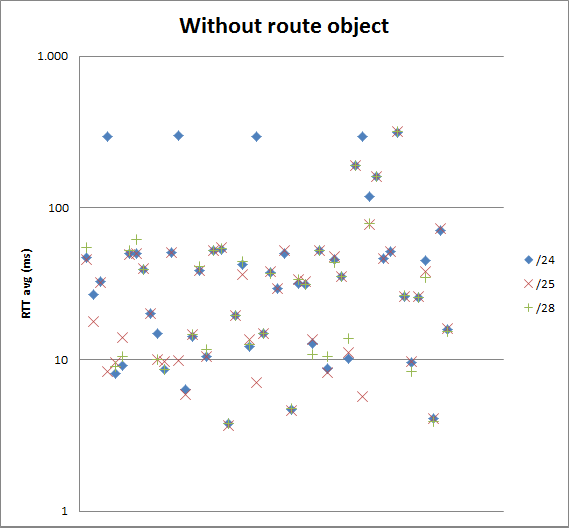Yesterday RIPE Labs announced a new test to measure propagation of longer than /24 IPv4 prefixes. The scope of these prefixes is to allow small allocations from the 23.128/10 net block that ARIN reserved to facilitate IPv6 deployment, but it could be impaired by filters and routing policies commonly deployed all around the net.
While looking forward to the RIPE results I couldn’t help glancing at the current situation as seen by a bunch of RIPE Atlas probes, so I performed some small tests on my own.
Measurements
The measurements I created are based on 500 random probes from the world wide area and have been used to ping the IP addresses announced by RIPE RIS (AS12654); these IP addresses are split in 2 main groups: one group has 3 addresses each one from a prefix (/24, /25 and /28) with a registered route object, the other group has similar addresses but from prefixes without a registered route object.
Prefix Pingable IP Route object? My Atlas measurement ID 23.128.24.0/24 23.128.24.1 yes 1767799 23.128.25.0/25 23.128.25.1 yes 1767800 23.128.25.240/28 23.128.25.241 yes 1767801 23.128.124.0/24 23.128.124.1 no 1767802 23.128.125.0/25 23.128.125.1 no 1767803 23.128.125.240/28 23.128.125.241 no 1767804
All measurements use the same set of probes, taken from the first measurement (the /24 prefix with registered route object).
Of course, mine is only a partial view (500 probes) taken from a bigger partial view (all the RIPE Atlas probes) of the global Internet; please take my results with regard of this.
Results
Data collected by RIPE Atlas have been parsed with a small python script that I used to match the results. It uses the RIPE Atlas Sagan library.
Reachability
From the first 3 measurements, 497 probes received at least one response from the /24 prefix with the registered route object; of those, only 57 received responses from the /25 prefix and 41 from the /28 prefix too.
Also 497 probes received responses from the /24 prefix without the registered route object; of those, 52 received responses from the /25 prefix and 38 from the /28 prefix too.

Performances
For those probes which reach the /25 and the /28 prefix the average RTT seems to be pretty stable regardless of the prefix size.
Probes distribution
Here it is:
More and deeper tests may be useful to reveal AS paths and peering/transit relationships impacts on these measurements; maybe I’ll blog another post as soon as possible, or – better yet – maybe RIPE Labs folks will write about them in their results.
Conclusions
As far as I can see from the measurements I run (based on a small sample of probes), reachability of smaller than /24 prefixes is almost unaffected by the presence of registered route objects; who receives the registered net also receives the unregistered one. From the performances point of view, when the smaller prefixes are reached, RTTs are not better nor worse than /24 prefixes.
The real question is: what’s the portion of Internet that right now succeed to reach these prefixes?
I guess that some efforts will be needed in order to have ISPs to review their routing policies and accept the new small prefixes from the reserved pool.
References
RIPE Labs, Propagation of Longer-than-/24 IPv4 Prefixes – https://labs.ripe.net/Members/emileaben/propagation-of-longer-than-24-ipv4-prefixes
ARIN, Policy Proposal 2008-5 – Dedicated IPv4 block to facilitate IPv6 deployment- https://www.arin.net/policy/proposals/2008_5.html
ARIN, Number Resource Policy Manual (NRPM), adoption of Dedicated IPv4 block to facilitate IPv6 Deployment – https://www.arin.net/policy/nrpm.html#four10
ARIN, announcement of 23.128.0.0/10 reservation – https://www.arin.net/announcements/2014/20140130.html
Latest posts by Pier Carlo Chiodi (see all)
- Good MANRS for IXPs route servers made easier - 11 December 2020
- Route server feature-rich and automatic configuration - 13 February 2017
- Large BGP Communities playground - 15 September 2016




Leave a Reply